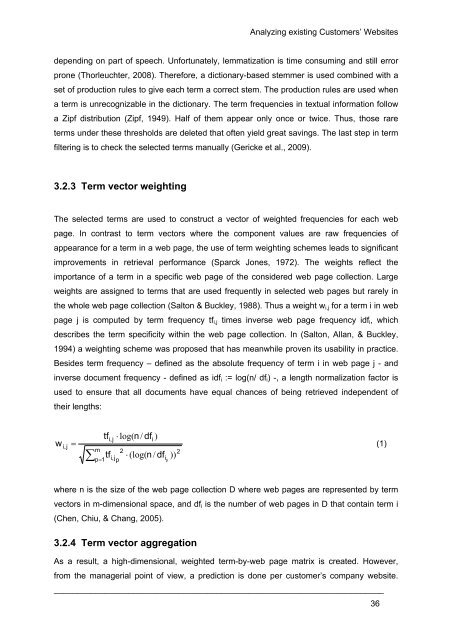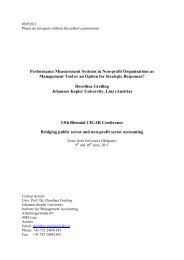ESSAYS ON TEXT MINING FOR IMPROVED DECISION MAKING ...
ESSAYS ON TEXT MINING FOR IMPROVED DECISION MAKING ...
ESSAYS ON TEXT MINING FOR IMPROVED DECISION MAKING ...
Create successful ePaper yourself
Turn your PDF publications into a flip-book with our unique Google optimized e-Paper software.
Analyzing existing Customers’ Websites<br />
depending on part of speech. Unfortunately, lemmatization is time consuming and still error<br />
prone (Thorleuchter, 2008). Therefore, a dictionary-based stemmer is used combined with a<br />
set of production rules to give each term a correct stem. The production rules are used when<br />
a term is unrecognizable in the dictionary. The term frequencies in textual information follow<br />
a Zipf distribution (Zipf, 1949). Half of them appear only once or twice. Thus, those rare<br />
terms under these thresholds are deleted that often yield great savings. The last step in term<br />
filtering is to check the selected terms manually (Gericke et al., 2009).<br />
3.2.3 Term vector weighting<br />
The selected terms are used to construct a vector of weighted frequencies for each web<br />
page. In contrast to term vectors where the component values are raw frequencies of<br />
appearance for a term in a web page, the use of term weighting schemes leads to significant<br />
improvements in retrieval performance (Sparck Jones, 1972). The weights reflect the<br />
importance of a term in a specific web page of the considered web page collection. Large<br />
weights are assigned to terms that are used frequently in selected web pages but rarely in<br />
the whole web page collection (Salton & Buckley, 1988). Thus a weight wi,j for a term i in web<br />
page j is computed by term frequency tfi,j times inverse web page frequency idfi, which<br />
describes the term specificity within the web page collection. In (Salton, Allan, & Buckley,<br />
1994) a weighting scheme was proposed that has meanwhile proven its usability in practice.<br />
Besides term frequency – defined as the absolute frequency of term i in web page j - and<br />
inverse document frequency - defined as idfi := log(n/ dfi) -, a length normalization factor is<br />
used to ensure that all documents have equal chances of being retrieved independent of<br />
their lengths:<br />
tfi,<br />
j ⋅ log( n / dfi<br />
)<br />
w i,<br />
j =<br />
(1)<br />
2<br />
tf ⋅ (log( n / df ))<br />
m<br />
∑ p=<br />
1<br />
2<br />
i,<br />
jp<br />
i<br />
p<br />
where n is the size of the web page collection D where web pages are represented by term<br />
vectors in m-dimensional space, and dfi is the number of web pages in D that contain term i<br />
(Chen, Chiu, & Chang, 2005).<br />
3.2.4 Term vector aggregation<br />
As a result, a high-dimensional, weighted term-by-web page matrix is created. However,<br />
from the managerial point of view, a prediction is done per customer’s company website.<br />
_______________________________________________________________________<br />
36

















